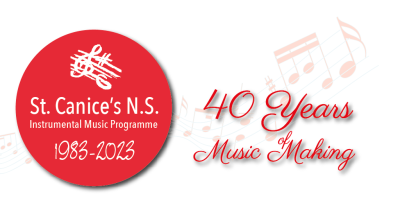The video shows Ruth Kent 6th Class (Orchestra Leader) 2013-2014 interviewed and performing in Senior Orchestra in the programme “Meet The Orchestra” recorded in May 2013 and aired on RTE Junior in September 2013
The violin is the smallest member of the string family. Sound is produced by drawing the bow across one of the four strings or by plucking the string with a finger. All string instruments produce sound in the same manner. The main differences are the sizes of the instruments and how high or low each instrument can sound.
The violin comes in just two pieces, the instrument and the bow. The bow uses horsehair or a synthetic material to vibrate the strings as it is drawn over the instrument. The violin has four stings which are normally tuned to a G, D, A and E.
The violin is played with the instrument under the chin on the left side. The right hand holds the bow at the bottom (the bottom of the bow is called the “Frog”) and draws the bow over the strings.
The violin is a very old instrument. It has been basically unchanged for hundreds of years. It may sometimes be called a fiddle for country music or a violin for dozens of other types of music but the instrument is the same regardless of where it is played. Some variations on the violin include modern electric instruments which are very similar in the way they are played. They are just missing the body and shape of a violin. The sound is amplified electronically rather than from the body of the instrument.
A unique feature of student violins is the huge variation in sizes from full size, to 3/4 size, to 1/2 size all the way down to a 1/16 size violin. The correct size for a student depends on the arm length and overall size of the student. Students are measured by our violin teachers to determine the correct size of instrument for them as individuals.
St Canice’s violinists perform in the Junior orchestra and Senior orchestra and may also get together with fellow string, woodwind or brass players to form quartets or other smaller performing groups.
